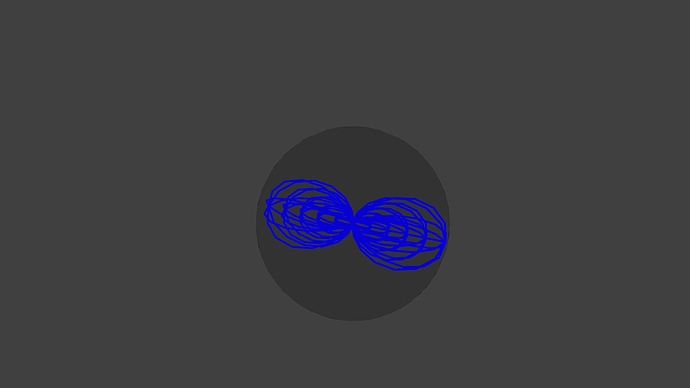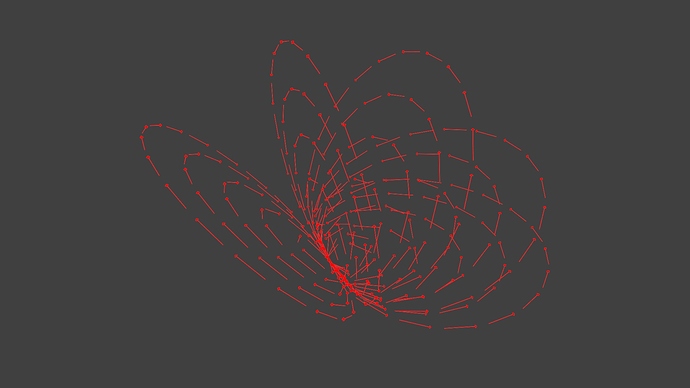The POV-RAY script above (although the author used Mathematica to help) is the literal script he offered for describing this image:

What is interesting to me is that while RickyBlender has done a great job at now having created a 3-dimensional representation of the field lines as revolved planar elements, the suggests for producing a true 3-dimensional representation still come back to a question of: 1) volumetric shaders, 2) OSL shaders, or 3) Particles. For these, the basic input ought to be something that is related to what RickyBlender is doing with digitizing the information from the French link provided above.
Here, POV-RAY takes a Bounding Box as a 3-dimensional domain and voxelizes its interior according to whatever script is provided by the user: http://www.mpa-garching.mpg.de/~mselig/povray/povray.html

As we can see, one benefit here is that the entire Volumetric domain is specifically scripted by the user. Beyond that, however, is how this method starts to look like a Volumetric OSL shader in Blender, but is also reminiscent of the Volumetric domain declared by a smoke/fire sim, which is then voxelized and looks remarkably like this POV-RAY density example. I also just peeked at Secrop’s link, and on (I believe) page 34, there are several images of vectors showing airflow over a tire (or something like that), but it is very similar to the above: a cubic domain and voxelized densities along vector paths.
So, in a certain sense, I feel that if one were working with a Volumetric shader in a simple cubic domain, the only difference between an OSL shader and the POV-RAY representation would be the language it is written in.
However, if this approach is taken, i want to avoid a simple depiction/representation of 3-dimensional MFLs…which, while interesting, we could do just as easily with concentric ellipses that “look right”. What is far more interesting than a representation is a SIMULATION…which is why I am really eager to see how RickyBlender’s script is operationalizing the above equations. Beyond drawing Field Lines, there is the issue of interaction among field lines of two objects. With no second object within the domain, the field lies will look the same. However, upon producing a second object in the domain, rather than depicting two objects with two independent sets of Field lines that do not interact and simply intersect, a simulation would instead draw the lines repulsing and curving together.
So…depending on the approach…I think there is a problem of “perspective” that I lack the language to describe, other than simply calling it the “inside-out problem” and it has to do with whether we are taking our object of interest as the lines themselves, or the volume of the domain.
For what I mean by this, I refer back to Secrop’s comment that “the field itself doesn’t produce any lines”. This is true, and I kind of mentioned it before…the MFL’s a representations of the magnetic field. So there are two approaches. The first, and no less impressive, is the approach of RickyBlender. He takes the vector lines as the object and draws them in space. With a single magnetic object in the domain, this is fine as most of the lines will be closed and concentric. However, when a second object is added, I suspect that the complexity of the lines in a true simulation will become much more difficult to draw, as often that will become twisted and bent and parabolic, eschewing a closed ellipse.
The second approach takes to heart Secrop’s comment above. The key to this is that the object of interest is not necessarily the lines themselves, but the volume, and not just the volume, but the volume as a medium. To think of the classic depiction of magnetic field lines, the lines themselves are not the medium. Rather, the iron filings sprinkled on the paper are the medium. At first, the iron filings are evenly distributed on the paper. In the presence of the magnetic field, the filings are forced to bunch up, drawing the lines not as independent vectors, but rather as areas of density.
So…I think maybe there are two pursuits here. One, RickyBlender’s (man…I keep wanting to say RickyBobby…I hope I didn’t accidentally type that anywhere) script, seeing how far that can be taken toward drawing MFLs as vectors. Or two…using either particles or an OSL volume or something to set up an evenly distributed medium, and then in the presence of objects simulating the reaction of that medium to those objects.
Until I see RickyBlender’s script, I will trawl through the resources that have already come up…and, since I am new to both OSL and POV-RAY (if it is useful or enlightening remains to be seen)…investigating how they draw volumes.
I really appreciate the comments here. Even if there is no smashing success at the end of the road, I think this is interesting to think about.






